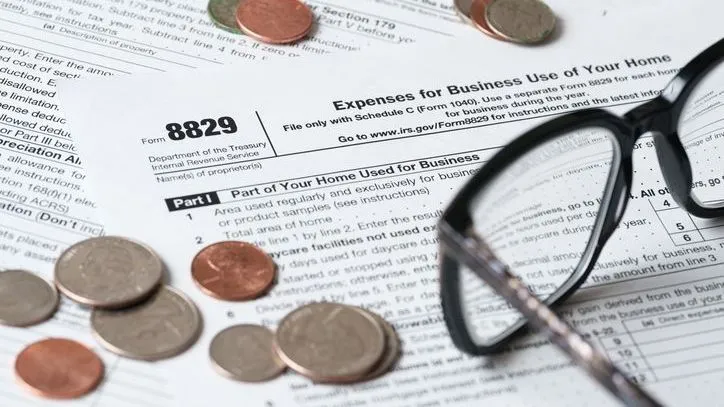Form 8829 is used to claim the home office deduction by calculating the business-related portion of home expenses. Self-employed individuals and freelancers can deduct costs such as rent, utilities and depreciation if they use a designated space exclusively for work. However, the IRS sets specific guidelines for eligibility, including regular and exclusive business use of the home office. By completing Form 8829, qualifying taxpayers can reduce their taxable income based on the percentage of their home dedicated to business activities.
A financial advisor with tax planning expertise can be a valuable resource for business owners and investors, alike. Connect with a financial advisor.
What Is the Home Office Deduction?
The home office deduction enables eligible taxpayers to write off a portion of their household expenses if they use part of their home exclusively for business. This deduction applies to self-employed individuals, independent contractors and freelancers.
Regular employees can’t claim this deduction. And Form 8829 can’t be used by partners or other business owners who claim these deductions elsewhere on their returns.
Some of the activities that qualify for business use include:
- Serving as the principal place of business for your trade or occupation
- Meeting with clients, customers or patients
- Storing inventory or samples
- Providing some types of daycare
Home-based office users can write off both direct expenses, such as repairs made specifically to the office space, and indirect expenses, including a percentage of rent, mortgage interest, utilities and property taxes. There are two ways to calculate the deduction:
- Simplified method: This provides a standard rate per square foot of office space and does not require filing Form 8829.
- Actual expense method: This requires detailed records of costs.
Claiming a deduction for a home office may increase the chances of an IRS audit. It’s important to have proper documentation supporting how the space is used and, if using the actual expense method, detailing costs.
Using Form 8829 to Claim the Home Office Deduction

Form 8829 is used by self-employed individuals who operate a business from home and want to deduct a portion of their household expenses. This form is filed alongside Schedule C (Profit or Loss from Business) and helps determine the portion of rent, utilities, mortgage interest, property taxes and other eligible costs that can be deducted.
Employees generally cannot use Form 8829 due to tax law changes under the Tax Cuts and Jobs Act.
One important requirement is that the home office meet the exclusive and regular use criteria. Exclusive use means the space must be dedicated solely to business activities—using a room for both work and personal purposes disqualifies it. Regular use refers to consistent, ongoing business activity rather than occasional or incidental use.
When to Use Form 8829
Form 8829 is only required when using the actual expense method, which involves itemizing home office-related costs and calculating a percentage based on the workspace size. Those opting for the simplified method, which allows a flat rate of $5 per square foot (up to 300 square feet), do not need to file Form 8829 and instead claim the deduction directly on Schedule C.
What Can You Deduct on Form 8829?
A variety of home expenses can be partially deducted if they relate to the business use of your home. The deduction amount depends on the percentage of your home used exclusively for business.
- Rent or mortgage interest: Rent is deductible if you lease your home, while homeowners can deduct the business-use portion of mortgage interest. Payments that reduce the principal amount of the mortgage cannot be deducted.
- Property taxes: Homeowners can deduct a percentage of real estate taxes based on business use.
- Utilities: Electricity, water, gas and trash removal costs can be deducted proportionally.
- Homeowners or renters insurance: The portion of insurance covering the home office is deductible.
- Maintenance and repairs: Direct repairs to the office are fully deductible; general home repairs are prorated.
- Depreciation: Homeowners can deduct depreciation on the business-use portion of their home.
Form 8829 Instructions: How to Fill it Out
Form 8829 consists of four parts. Filling them out correctly will establish that you are using a portion of your home for business, calculate your deduction, account for depreciation and track unused deductions that you may be able to apply in future years.
Part I: Business Use of Your Home
This section establishes the percentage of your home used exclusively for business. Start by measuring the total square footage of your home and the square footage of your home office. Divide the office space by the total home size to determine the business-use percentage.
For example, say your home is 2,000 square feet and you use a 500-square-foot spare bedroom as an office. The business use percentage would be 500 divided by 2,000 = 25%.
This percentage will be used to allocate indirect expenses, such as rent and utilities. For instance, say your rent is $2,000 per month or $24,000 per year and you use 25% of your home for business. You could deduct $24,000 times 25% or $6,000 for rent. If you operate multiple businesses from your home, you must allocate space accordingly and may need to file a separate Form 8829 for each business.
Part II: Figure Your Allowable Deduction
This section breaks down eligible home office expenses into direct and indirect costs. Direct expenses—such as repairs, painting or renovations made solely to the home office—are fully deductible. Indirect expenses—such as mortgage interest, rent, property taxes, homeowner’s insurance and utilities—are deductible based on the business-use percentage calculated in Part I.
One limitation is that the deduction cannot exceed the gross income from the business. If expenses are greater than income, they must be carried forward. Part IV of the form covers this.
Part III: Depreciation of Your Home
For homeowners, this section calculates the depreciation of the business-use portion of the home. You must report the purchase price of the home, the value of the land (which is not depreciable), and the percentage of the home used for business.
The IRS provides depreciation tables that outline the annual percentage you can claim. Depreciation is typically based on a 39-year recovery period for non-residential real property.
Part IV: Carryover of Unallowed Expenses
If total expenses exceed business income, this section tracks unused deductions that can be carried forward to future years. These expenses may be deductible in a later tax year if the business generates sufficient income.
Bottom Line

Claiming the home office deduction through Form 8829 provides a way for self-employed individuals to offset the costs of maintaining a workspace within their home. Meeting the IRS criteria for exclusive and regular use is key, and those opting for the actual expense method must carefully complete Form 8829 to properly allocate deductions. A simplified method of claiming this deduction does not require Form 8829.
Tax Planning Tips
- Manage your investment transactions to control the timing of capital gains. Consider deferring the sale of appreciated investments until a tax year when your income may be lower, or strategically harvest losses to offset gains and reduce your taxable income. SmartAsset’s capital gains tax calculator can help you estimate your tax liability.
- Some financial advisory firms offer tax planning and tax preparation services in addition to portfolio management and financial planning. Finding a financial advisor doesn’t have to be hard. SmartAsset’s free tool matches you with vetted financial advisors who serve your area, and you can have a free introductory call with your advisor matches to decide which one you feel is right for you. If you’re ready to find an advisor who can help you achieve your financial goals, get started now.
Photo credit: ©iStock.com/cyano66, ©iStock.com/Laurence Dutton, ©iStock.com/Pekic
